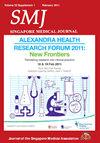Unilateral abducens nerve avulsion injury following trauma
IF 1.7
4区 医学
Q2 MEDICINE, GENERAL & INTERNAL
引用次数: 0
Abstract
Dear Sir, While abducens nerve palsy is commonly seen in clinical practice, abducens nerve palsy secondary to an avulsion injury is uncommon. In a retrospective study documenting the causes of abducens nerve palsy, only up to 3.1% were attributed to trauma; the most common cause in adults was related to vascular ischaemia.[1] Unilateral abducens nerve palsy is found in only 1%–2.7% of all head traumas.[2] Here, we present a case of unilateral abducens nerve injury following trauma. A 60-year-old woman with no significant medical history was involved in a road traffic accident. Initial computed tomography (CT) of the brain revealed bilateral acute subarachnoid haemorrhage, as well as an acute subdural haemorrhage along the posterior interhemispheric falx. Multiple facial bone fractures were identified [Figure 1], including fractures of both orbital floors and lateral walls, lamina papyracea, maxilla and left zygomatic process. No fracture was identified along the course of the left abducens nerve. Of note, the left petrous apex in the region of Dorello’s canal, cavernous sinus and lateral rectus muscle appeared unremarkable.Figure 1: Axial CT images in the bone windows. (a) Acute fractures of both lateral orbital walls, lamina papyracea and left zygomatic process (circles). (b) There is also an acute fracture of the left lateral sphenoid wall (circle). Of note, the left petrous apex appears unremarkable, with no acute fracture.The patient subsequently underwent open reduction internal fixation of both zygomaticomaxillary complex fractures with left orbital floor reconstruction 26 days after the accident. Intraoperatively, forced duction test did not reveal any restriction on eye movement. Postoperatively, it was noted that the patient possessed signs of left abducens nerve palsy, with persistent medial deviation and failure of abduction of the left eye. These were likely not detected during the initial few weeks in view of extensive periorbital soft tissue swelling from the facial and orbital fractures, which resolved after surgical fixation. Contrast-enhanced CT of the brain did not demonstrate any new finding to explain the left abducens nerve palsy. Magnetic resonance imaging of the brain and orbits, including a three-dimensional constructive interference in steady-state (3D CISS) sequence of the cranial nerves was performed 35 days after the accident. This showed a discontinuous left abducens nerve in the prepontine cistern, with subtle linear enhancement corresponding to its root exit zone [Figure 2]. Findings pointed towards a traumatic unilateral left abducens nerve avulsion injury resulting from the road traffic accident. An iatrogenic aetiology of the left abducens nerve avulsion was deemed less likely, as the surgery was mainly focused on facial and orbital fracture repairs, with no surgical intervention performed along the course of the left abducens nerve. The patient was subsequently referred to ophthalmology and managed conservatively.Figure 2: (a) Axial MR image with constructive interference in steady state (CISS) sequence shows discontinuity of the left abducens nerve in the prepontine cistern (circle). (b) Sagittal oblique reconstruction of the MR image with CISS sequence shows left abducens nerve avulsion (circle). (c) Axial pre-contrast and (d) post-contrast T1-W MR images show a linear enhancement corresponding to the left abducens nerve root exit zone (circle).The abducens nerve is an important nerve involved in the extraocular movements of the globe. Its long course, in addition to the nerve being fixed in Dorello’s canal, makes it vulnerable to trauma. A common site of injury is at the petrous apex as the nerve enters Dorello’s canal.[3] The usual mechanism of injury is contusion/stretching along its course during vertical displacement of the brain, which is evident during head trauma.[3] With the advent of MR imaging, visualisation of the abducens nerve is possible. The most useful sequence for imaging includes the steady-state Gradient Echo technique, 3D CISS or fast imaging employing steady-state acquisition. These are heavily T2-weighted 3D volumetric sequences capable of acquiring very thin slices and allowing reconstruction in all three planes.[4] In this way, it is possible to analyse the morphological features of structures next to the cerebrospinal fluid-containing spaces, including the cranial nerves. In conclusion, we encountered an uncommon case of unilateral abducens nerve avulsion injury following trauma, of which there are fewer than five documented cases reported in the English literature.[5-7] Magnetic resonance imaging using CISS sequences plays an important role in diagnosis. Financial support and sponsorship Nil. Conflicts of interest There are no conflicts of interest.创伤后单侧外展神经撕脱伤
虽然外展神经麻痹在临床上很常见,但继发于撕脱伤的外展神经麻痹并不常见。在一项记录外展神经麻痹原因的回顾性研究中,只有3.1%归因于创伤;成人中最常见的病因与血管缺血有关单侧外展神经麻痹仅占所有头部外伤的1%-2.7%在此,我们报告一例外伤后单侧外展神经损伤。一名无明显病史的60岁妇女发生了一起道路交通事故。脑部的初始计算机断层扫描(CT)显示双侧急性蛛网膜下腔出血,以及沿后半球间镰的急性硬膜下出血。发现多发面骨骨折[图1],包括眶底和侧壁、纸莎草层、上颌骨和左颧突骨折。左侧外展神经沿程未发现骨折。值得注意的是,Dorello管、海绵窦和外侧直肌区域的左岩尖未见明显变化。图1:骨窗轴位CT图像。(a)双侧眶壁、纸莎草层和左颧突急性骨折(圆形)。(b)左侧蝶侧壁(圆形)也有急性骨折。值得注意的是,左侧岩尖不明显,无急性骨折。事故发生26天后,患者接受了双侧颧腋复合体骨折的切开复位内固定和左眶底重建。术中强制导流试验未见眼动受限。术后发现患者有左外展神经麻痹的症状,伴有持续的内偏和左眼外展失败。由于面部和眶部骨折引起广泛的眶周软组织肿胀,这些可能在最初几周内未被发现,手术固定后消退。脑部增强CT未发现任何解释左展神经麻痹的新发现。在事故发生后35天进行脑和眼眶的磁共振成像,包括脑神经的三维稳态构造干涉(3D CISS)序列。图2显示左侧外展神经在基底池处不连续,其根出口区有轻微的线性增强。结果表明是由于道路交通事故造成的外伤性单侧左外展神经撕脱伤。左展神经撕脱的医源性原因被认为不太可能,因为手术主要集中在面部和眶骨折修复,没有沿着左展神经的路线进行手术干预。患者随后转诊至眼科并接受保守治疗。图2:(a)稳态(CISS)序列的轴向干涉MR图像显示左展神经前池(圆形)不连续性。(b) CISS序列矢状斜位重建MR图像显示左外展神经撕脱(圆形)。(c)轴向对比前和(d)对比后的T1-W MR图像显示与左展神经根出口区(圆形)对应的线性增强。外展神经是参与眼球外运动的重要神经。它的过程很长,而且神经固定在多雷洛管中,这使得它很容易受到创伤。常见的损伤部位是神经进入多雷洛管的岩尖通常的损伤机制是在大脑垂直位移过程中的挫伤/拉伸,这在头部创伤中很明显随着核磁共振成像的出现,外展神经的可视化成为可能。最有用的成像序列包括稳态梯度回波技术、3D CISS或采用稳态采集的快速成像。这些是重t2加权的3D体积序列,能够获得非常薄的切片,并允许在所有三个平面上重建通过这种方法,可以分析脑脊液空间附近结构的形态特征,包括脑神经。总之,我们遇到了一例罕见的创伤后单侧外展神经撕脱伤病例,其中在英文文献中报道的病例少于5例。[5-7]利用CISS序列进行磁共振成像在诊断中具有重要作用。财政支持及赞助无。利益冲突没有利益冲突。
本文章由计算机程序翻译,如有差异,请以英文原文为准。
求助全文
约1分钟内获得全文
求助全文
来源期刊

Singapore medical journal
MEDICINE, GENERAL & INTERNAL-
CiteScore
3.40
自引率
3.70%
发文量
149
审稿时长
3-6 weeks
期刊介绍:
The Singapore Medical Journal (SMJ) is the monthly publication of Singapore Medical Association (SMA). The Journal aims to advance medical practice and clinical research by publishing high-quality articles that add to the clinical knowledge of physicians in Singapore and worldwide.
SMJ is a general medical journal that focuses on all aspects of human health. The Journal publishes commissioned reviews, commentaries and editorials, original research, a small number of outstanding case reports, continuing medical education articles (ECG Series, Clinics in Diagnostic Imaging, Pictorial Essays, Practice Integration & Life-long Learning [PILL] Series), and short communications in the form of letters to the editor.
 求助内容:
求助内容: 应助结果提醒方式:
应助结果提醒方式:


